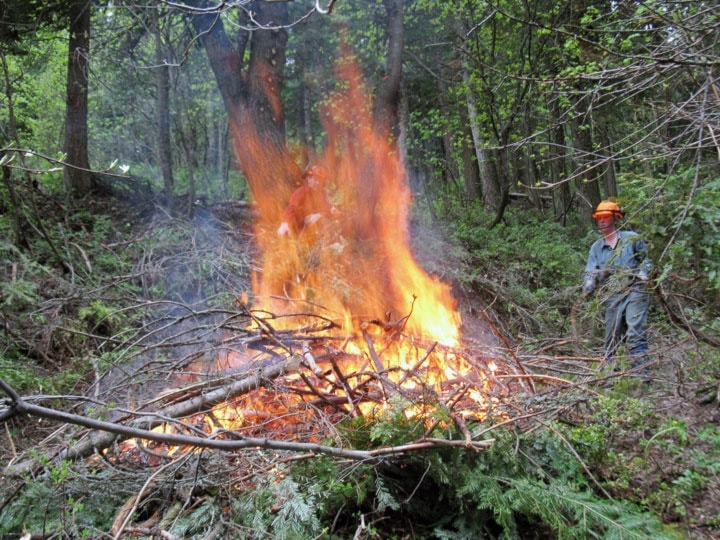The fuel treatment program to protect the perimeter of Rossland from wildfires started again on May 12 after being shut down by snow on Dec. 10, 2010, but project co-ordinator Don Mortimer says a big part of community wildfire protection depends on the active participation of private landowners.
The treatment involves removing the forest's "kindling", Mortimer said, to create a "shaded fuel break." Surface fuels and ladder fuels — small trees and low branches that can take the fire up to the crown — are removed, while logs and some standing dead trees are left behind to provide important wildlife habitat. To help build soil, logs are limbed and bucked so they make contact with the forest floor.
A "visual buffer" of small trees is also left in a strip along trails, but otherwise the result is a forest that appears more open and "walkable," an effect trail users can see for themselves in the Star Gulch reservoir area and above both the Iron Colt and Black Diamond subdivisions.
Another benefit of the program is the six-foot lengths of firewood-size logs stacked along the trails. "These will be moved to the trailhead just outside the Star Gulch reservoir gate for resident pick up," Mortimer said.
Eleven of the 22.4 hectares of city land slated for treatment around Rossland were completed last fall, and another eight hectares were partially treated as the snow first flew. Now the snow has melted, these areas will be revisited and the final four hectares will be finished this spring.
The wildfire protection plan targets key areas around town with the potential to ignite, but Mortimer noted, "the importance of private landowners 'FireSmarting' their own properties can't be overemphasized."
"A number of private properties on the community interface require fuel treatment to reduce their wildfire hazard," he explained, "but of course this publicly funded program is unable to provide hazard reduction on private properties. Property owners should get the FireSmart Homeowners Manual — a free publication available at city hall, the fire department, or at the insurance agency office downtown — go through the manual and apply the recommendations to their property."
"It's important that Rossland property owners recognize the potential for high intensity wildfires burning in the mountains above Rossland to burn non-FireSmart structures on the community perimeter or shower large quantities of embers into the townsite," Mortimer said. "These embers can ignite non-FireSmart structures in short order."
Mortimer, a specialist with more than 36 years of experience in forest fire management and a longtime Rossland resident, said the fuel treatment significantly reduces the chance that a fire started in the treated areas — for example, by embers lofted in by nearby fires — will develop into a destructive, high intensity wildfire."
He thinks the fuel treatments completed on some of the city's forested land will reduce the possibility of embers showering into the townsite, "however the fuel treatment program has only treated a small percentage of the forest lands."
High intensity wildfires can send embers further than two kilometres, but treatment that far out "is neither practical nor affordable," Mortimer explained. "Homeowners have to FireSmart their properties so that embers landing on and adjacent their structures are less likely to ignite and destroy those structures."
He stressed that even properties with minimal vegetation need to be "ember-proofed," as wind driven embers can ignite anything combustible.
With the Slave Lake fires occupying a lot of national attention, Mortimer was careful to draw several distinctions between the Slave Lake event and the wildfire risk Rossland faces.
"Slave Lake losses were more due to an extreme wind event than anything else," he explained.
"The forest fuels were very dry and no doubt contributed to the initial wind driven fire that surged into Slave Lake, but I'd suggest the majority of structures burned in that incident were ignited by firebrands created by the wind stripping burning pieces off of one house and depositing them downwind on other structures."
Although similar events have happened in Rossland, Mortimer credits stricter building codes and improved fire department capabilities for "more or less" putting an end to "city burning" fires, but "It's pretty impossible for any fire department to get a handle on that kind of fire spread once it gets established," he said.
"Fortunately, we don't get those sustained high wind speeds or the very low 'pre-green up' forest fuel moistures of Northern Alberta's boreal forest here in Rossland," he said, but we do face potentially severe consequences when, "inevitably," wildfire visits us. Structure fires on windy days could be disastrous.
Visit city hall, the fire department, or RHC Insurance to get a free copy of the FireSmart Homeowners Manual.
